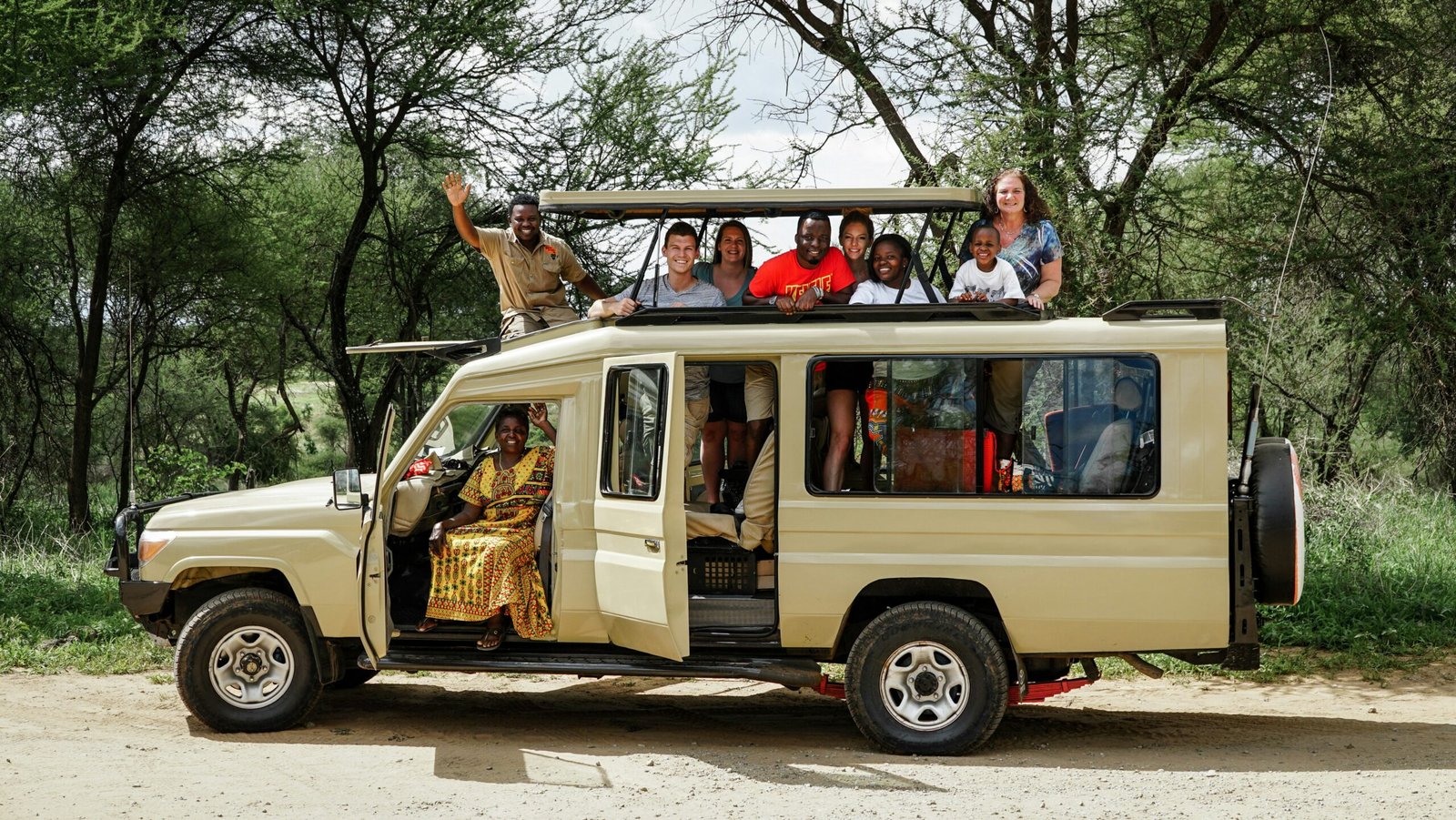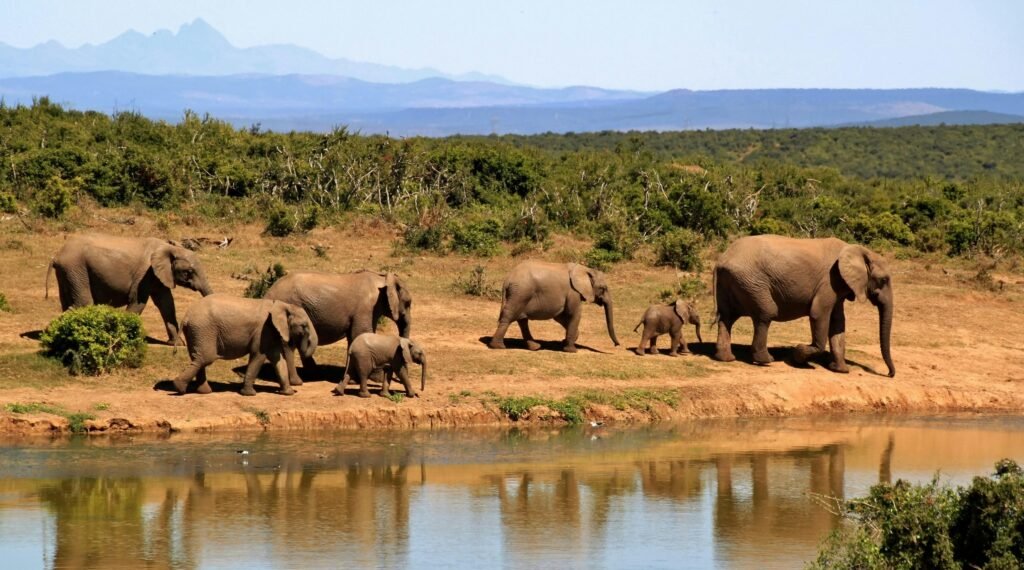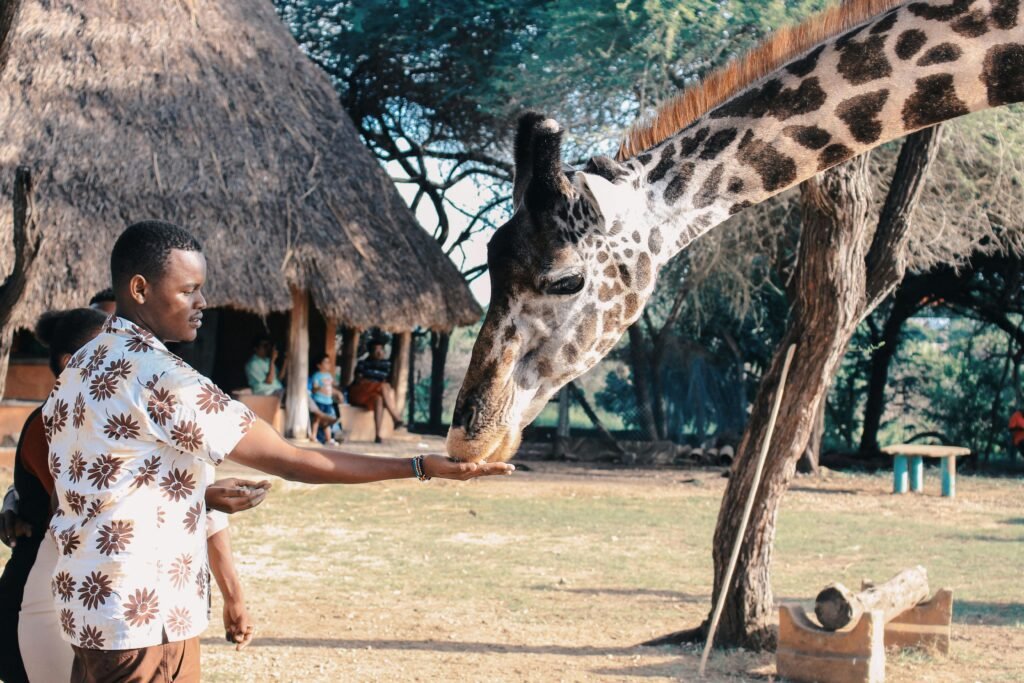Introduction to African Safaris
African safaris represent an unparalleled opportunity to connect with nature and experience the continent’s rich biodiversity. The allure of these adventures extends beyond the chance to observe iconic wildlife; it encompasses the stunning landscapes, culturally rich encounters, and the thrill of exploration. Each year, millions of travelers are drawn to recognizable terrestrial habitats that harbor some of the planet’s most impressive species, from majestic elephants to elusive leopards.

Embarking on a safari in Africa provides visitors with a unique perspective on ecosystems that have inspired countless documentaries and literary works. Destinations such as the Serengeti in Tanzania, the Maasai Mara in Kenya, and Kruger National Park in South Africa offer distinct experiences that cater to a variety of preferences, enhancing the allure of wildlife tourism. Whether one opts for a lodge-based experience or a rugged camping safari, the overarching aim remains the same: to witness the breathtaking interplay of flora and fauna in their natural habitats.
Understanding the nuances of different safari types and the significance of seasonal timing can greatly enhance the experience of wildlife enthusiasts. Various forms of safaris include game drives, walking safaris, and even boat safaris along rivers and lakes, each offering unique vantage points and interaction opportunities. Timing is crucial, as wildlife behavior can vary between seasons, impacting the likelihood of encountering certain species. For instance, during the dry season, animals gather around rare water sources, providing optimal viewing opportunities. On the other hand, the wet season brings life to the landscape, resulting in lush scenery and vibrant animal movements. This guide aims to delve into the top safari destinations in Africa, the animals you can expect to see, and the best seasons to witness these incredible wildlife experiences.
Top Safari Destinations in Africa
Africa boasts a wealth of incredible safari destinations, each offering unique experiences and unforgettable wildlife encounters. Among the most renowned is the Serengeti National Park in Tanzania. Famous for its annual wildebeest migration, this vast savannah is home to diverse species, including lions, leopards, and elephants. The expansive landscape allows for excellent game viewing opportunities year-round, with particular excitement during the migration from June to September.
Another prominent location is Kruger National Park in South Africa. This park is one of Africa’s largest game reserves, featuring a remarkable variety of habitats that support an impressive range of wildlife. Visitors can expect to see the Big Five—lion, leopard, elephant, buffalo, and rhinoceros—alongside numerous bird species. Accessibility is facilitated by well-maintained roads and numerous accommodations, making it a favored choice for both novice and seasoned safari-goers.
The Masai Mara National Reserve in Kenya is also among the top safari destinations, famed for its dramatic landscapes and abundant wildlife. The reserve offers exceptional opportunities for witnessing the Great Migration as wildebeests and zebras traverse the Mara River. Unique cultural experiences can be gained from interactions with the Maasai people, who inhabit the region, enhancing the overall adventure.
Other significant destinations include Etosha National Park in Namibia, known for its salt pans and prolific wildlife sightings at waterholes, and Chobe National Park in Botswana, renowned for its large elephant population. Each of these destinations provides not only breathtaking scenery but also distinct wildlife experiences. As such, travelers can tailor their safari experience to align with specific interests and preferences while discovering Africa’s vibrant natural heritage.
When to Go: Understanding Safari Seasons
When planning a safari in Africa, understanding the seasonal variations is critical for maximizing wildlife viewing opportunities. The continent experiences distinct seasons categorized into the dry and wet seasons, each influencing the behavior of animals and the accessibility of national parks and reserves. Typically, the dry season, which spans from May to October, is regarded as the prime time for safaris. During this period, animals are more easily observable as they congregate around water sources, making them more visible to keen-eyed visitors.

The wet season, running from November to April, presents a different experience. While landscapes become verdant and the scenery is breathtaking, the wildlife behavior does change. Many animals engage in breeding activities, leading to the birth of young, which can be a captivating sight for visitors. For instance, the Great Migration that occurs in the Serengeti and Masai Mara usually peaks around July to September, offering spectacular opportunities to witness herds of wildebeest and zebras on their perilous journey across the plains. Planning your safari around this migration not only allows for impressive encounters but also chances to see predators like lions and cheetahs in action, capitalizing on the abundance of prey.
However, the timing of your visit should also align with specific wildlife experiences you wish to have. For example, January to March is often termed the calving season, when numerous herbivores give birth, creating a natural spectacle as young animals first encounter their surroundings. Understanding these cycles can aid significantly in choosing the best months to book a safari adventure. Travelers should, therefore, consider their wildlife interests and plan accordingly, as each season offers unique opportunities to witness Africa’s vast and varied fauna.
A Closer Look at Wildlife: What Animals to Expect
Embarking on an African safari is a thrilling experience, enamored with the opportunity to witness a multitude of wildlife in their natural habitat. Among the most sought-after encounters are the legendary “Big Five”: lions, elephants, buffalos, leopards, and rhinoceroses. Each of these species showcases extraordinary characteristics that enthrall nature enthusiasts. The lion, often dubbed the “king of the jungle,” exemplifies strength and social bonding within prides. Elephants are notable for their intelligence and complex social structures; they are the largest terrestrial mammals, wading through savannahs and forests with grace. Buffalos represent strength in numbers, commonly seen in herds, portraying resilience in the African wilderness.

Leopards, famed for their elusive nature, cling to the treetops, providing a fascinating glimpse into their stealthy hunting techniques. Rhinos, with their distinctive horns, evoke a sense of grandeur but also demand attention due to conservation efforts targeting their endangered status. Beyond the Big Five, an African safari offers encounters with diverse wildlife. Giraffes, with their distinctive long necks, gracefully browse treetops, while zebras exhibit their striking black and white stripes, an adaptation that has intrigued biologists for years. These social animals are often observed grazing together, contributing to the vibrant tapestry of the savannah.
In addition to these iconic species, safaris may unveil a variety of other fascinating animals. Cheetahs, known for their unparalleled speed, can be spotted hunting in the early morning. Hippos wallow in rivers and lakes, giving onlookers a chance to appreciate their immense size and unique life in water. The spectacle of birdlife, from the majestic African fish eagle to the vibrant lilac-breasted roller, adds to the auditory and visual symphony of the safari experience. Exploring these species on an African safari not only satisfies the adventurous spirit but also fosters a deep appreciation for the continent’s rich biodiversity.
Unique Safari Experiences: Beyond Game Drives
While traditional game drives are a cornerstone of the safari experience, Africa offers a plethora of alternative safari adventures that can provide a deeper connection to the continent’s stunning wildlife and rugged landscapes. Among these distinctive experiences are walking safaris, boat safaris, and hot air balloon safaris, each presenting unique advantages and breathtaking perspectives of Africa’s natural wonders.

A walking safari allows participants to immerse themselves in the environment, offering a more intimate experience with the flora and fauna. Accompanied by knowledgeable guides, participants can observe animal tracks, learn about medicinal plants, and appreciate the subtle sounds of the wilderness. This type of safari promotes a greater understanding of the ecosystem as guests venture into areas typically inaccessible by vehicle.
Boat safaris present a different vantage point from which to observe wildlife. Regions like Botswana’s Okavango Delta are best experienced from the water, where guests can glide silently past riverbanks, watching animals such as elephants and hippos in their natural habitats. This mode of transport not only allows for unobtrusive wildlife observation but can also provide an opportunity for birdwatching, as many species nest along the shorelines.
For those seeking a truly unforgettable experience, a hot air balloon safari offers a breathtaking aerial view of the savannah. As the sun rises and paints the landscape in hues of orange and gold, passengers float above the terrain, spotting herds of wildebeest and prides of lions from a remarkable height. This unique perspective of wildlife offers unrivaled photo opportunities and a serene appreciation for the vastness and beauty of the African landscape.
Incorporating these alternatives into your wildlife adventures can enhance your safari experience, revealing the diverse ecosystems and unique animal behaviors that define Africa’s wilderness. Each of these experiences exemplifies how the exploration of wildlife can encompass far more than just game drives, presenting guests with a richer understanding of the intricate balance of nature.
Eco-Tourism and Responsible Safari Practices
Eco-tourism encompasses a range of responsible travel practices, focusing on minimizing environmental impact while promoting conservation and supporting local communities. In the context of African safaris, this approach plays a pivotal role in preserving the unique ecosystems and diverse wildlife that attract travelers from around the globe. Many safari lodges are now prioritizing sustainability, incorporating eco-friendly practices into their operations to foster a harmonious relationship between tourism and nature.
One way eco-tourism is integrated into safari experiences is through the development of lodges that utilize renewable energy sources and sustainable building materials. These accommodations often adopt water conservation measures and waste management systems to reduce their ecological footprint. For instance, solar panels are increasingly used to power lodges, while composting toilets and greywater systems help conserve limited water resources, particularly in arid regions.
Moreover, responsible safari practices extend beyond the lodges themselves. Tour operators are now encouraged to consider the environmental and social implications of their tours. This includes limiting the number of vehicles allowed in sensitive areas, ensuring wildlife is not disturbed during sightings, and following strict guidelines regarding wildlife interactions. By adhering to these protocols, both travelers and operators contribute to the preservation of wildlife habitats and minimize disruption to the animals in their natural environments.
In addition to preserving wildlife, eco-tourism fosters economic opportunities for local communities. When travelers choose sustainable safari experiences, they are supporting initiatives that prioritize community involvement, such as local guides, craftwork, and culturally immersive experiences. This not only enhances the traveler’s experience but also ensures that the benefits of tourism directly support the communities that live alongside valuable wildlife habitats.
Ultimately, eco-tourism and responsible safari practices are essential for ensuring that Africa’s incredible wildlife heritage can be enjoyed by future generations. By making informed choices as travelers, we can play an integral role in protecting these remarkable ecosystems and the species that inhabit them.
Planning Your Safari: Essential Tips and Preparations
Embarking on a safari adventure requires meticulous planning to ensure an unforgettable experience amid the breathtaking wildlife of Africa. One of the first steps is deciding on the type of safari that suits your preferences—options range from guided tours to self-driving excursions. Guided safaris are perfect for those who prefer a structured itinerary and expert insights into animal behaviors, while self-driving can offer flexibility and spontaneity for the more adventurous traveler.
When selecting a guided tour, consider the size of the group, the expertise of the guide, and the itinerary. Larger groups may detract from the intimacy of the experience, while knowledgeable guides enhance opportunities for wildlife sightings and provide valuable context. Self-driving requires familiarity with navigation and the necessary permits, but it offers the freedom to set your own pace and discover hidden gems off the beaten path.
Packing appropriately is crucial for your safari. Lightweight, breathable clothing suitable for the climate, as well as sturdy shoes, should be prioritized. Neutral-toned apparel is advisable to blend into the environment and avoid startling wildlife. Essential gear includes a good quality camera for capturing memorable moments, binoculars for wildlife spotting, and a sun hat for sun protection during drives.
Booking your safari in advance is recommended, particularly if you plan to visit during peak seasons. Researching various safari companies and their deals can help you find the best package suited to your needs. Additionally, familiarize yourself with health considerations and vaccinations required by different regions, ensuring a safe travel experience.
Ultimately, thorough preparation paves the way for a remarkable African safari. By understanding the various options available and planning accordingly, travelers can create lasting memories while exploring the continent’s stunning wildlife and landscapes.
Capturing the Moments: Photography on Safari
Photography on safari presents an exhilarating opportunity to document the spectacular wildlife and breathtaking landscapes that Africa has to offer. To ensure you capture these unforgettable moments, it is essential to equip yourself with the right camera gear. A good digital single-lens reflex (DSLR) or mirrorless camera with a versatile zoom lens can be pivotal. Use a lens with a focal length of at least 200mm to capture distant subjects without disturbing them. Additionally, a quality tripod or monopod will enhance stability, particularly during low light conditions often present in early mornings and late afternoons.

Timing is crucial when it comes to wildlife photography. The “golden hours” of dawn and dusk provide the softest light, enhancing the color and texture of your images. Animals are often most active during these hours, increasing your chances of spotting them. It is wise to familiarize yourself with their behavior and daily patterns, as this knowledge can dramatically affect your photography experience.
Ethical considerations should also guide your photography practices while on safari. Maintaining a respectful distance from the animals is paramount to avoid adding stress to their natural behaviors. Using a telephoto lens allows for impressive shots without intruding on the wildlife’s habitat. It is also important to adhere to guidelines provided by your safari guide, who will emphasize the need to respect the delicate ecosystems and the animals within them.
Lastly, consider the composition of your photographs. Utilize the rule of thirds to create balanced images, and don’t hesitate to experiment with various perspectives to elevate your shots. Such thoughtful attention to detail will lead to stunning photographs that not only capture the beauty of the wildlife but also respect their environment.
Conclusion: The Magic of African Safaris
African safaris provide an unparalleled opportunity to immerse oneself in the vibrant tapestry of wildlife, stunning landscapes, and rich cultures found throughout the continent. As we have explored in this guide, different destinations offer unique experiences, with each presenting its distinct ecosystems and majestic animals. From the vast savannas of the Serengeti to the lush wetlands of the Okavango Delta, every safari adventure provides a chance to connect with nature in profound ways that can be life-changing.
Timing is crucial when planning your safari, as the seasons dictate animal behaviors and migrations. The Great Migration in East Africa is one of nature’s most spectacular events, attracting numerous herds of wildebeest and zebras. However, for those yearning to witness the rich biodiversity of countries like Tanzania or South Africa, understanding the best times to visit can enhance the overall experience. Traveling during the dry season often results in easier wildlife viewing and more comfortable weather conditions, though some may prefer the vibrant landscapes that the rainy season offers.
Moreover, engaging in a safari goes beyond merely observing animals; it is about fostering a deeper appreciation for the natural world. The thrill of encountering elephants, lions, and other iconic species in their native habitats serves as a reminder of the importance of conservation and sustainable tourism. Therefore, it is essential for travelers to choose responsibly operated safari tours that prioritize the well-being of wildlife and the ecosystems they inhabit.
In conclusion, embarking on an African safari is an adventure like no other, offering unforgettable memories and transformative experiences that resonate long after returning home. Whether it’s your first trip or a return to familiar landscapes, the call of the wild is one that everyone should embrace, embarking on a journey of discovery in one of the world’s most breathtaking environments.






